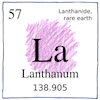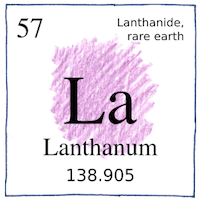Stockholm—Carl Gustaf Mosander
elements

|
Lanthanum
Carl Gustof Mosander found, lying hidden in a sample of cerite, an oxide of a new rare earth, which he named “that which lies hidden.” Little did he know that lying hidden in “that which lies hidden” were five other rare earths—gadolinium, praseodymium, neodymium, samarium, and europium.
Atomic number 57
Lanthanum is used in steel alloys and molybdenum alloys. Mischmetal of lanthanum and other rare earths are in the anode of nickel-metal hydride batteries and in lighter flints. Lanthanum oxide is in vacuum-tube emitters glass that resists alkali, glass that absorbs infrared, glass for camera and telescope lenses, and electrodes for gas tungsten arc welding.
Hidden stuff
A lurking suspicion. A recessive gene causing a bias an unexpected response. A hidden pattern. An unexplained secret. A mystery, an enigma. The element of surprise.



Lanthanum was the third rare earth that Mosander discovered, after yttrium and cerium. After this, Mosander discovered terbium and erbium. “Earth” is a term for a metallic oxide. They are called “rare” earths not because they are rare, but in the archaic sense of rare meaning “difficult.” They are difficult to separate.
See also in The book of science:
Readings in wikipedia:
Other readings: